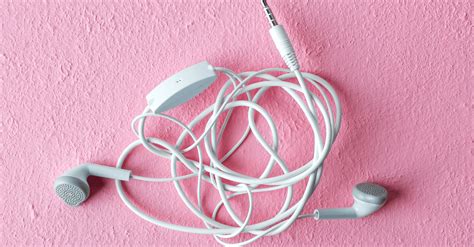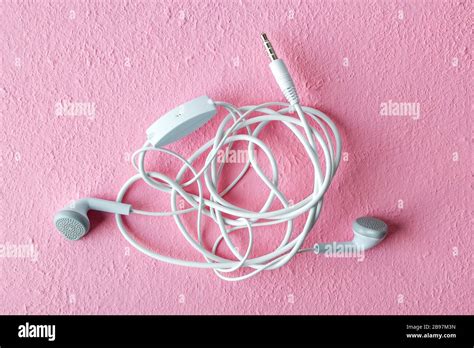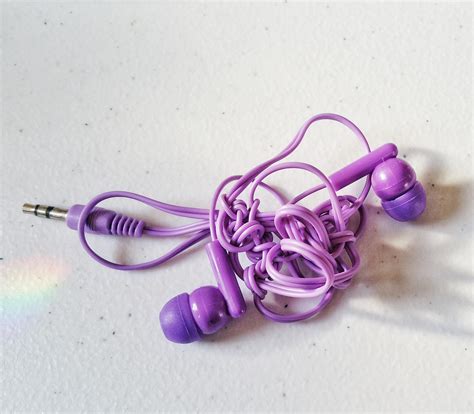Imagine you're trying to unwind your earphones for a relaxing evening with your favorite music or podcast, only to discover that your cable has turned into an intricate labyrinth of knots and tangles. Frustration sets in as you struggle to navigate through the chaotic mess, desperately seeking a solution to restore order. Fear not! In this guide, we will explore effective techniques to help you conquer the challenge of detangling your earphone cable with finesse and efficiency.
When faced with a snarled earphone cord, taking a calm and methodical approach is key. The art of unraveling lies not in brute force, but in patience and precision. Begin by laying your jumbled cable on a flat surface, allowing the cable to relax and unwind naturally. This will provide you with a clearer view of the knots and a better understanding of the task at hand. Remember, patience is a virtue – rushing through the detangling process may lead to further entanglement or even damage.
One effective technique to tackle the intricate mess is known as the "loop and pull" method. This method involves creating a loop in the cable by holding the connector end firmly in one hand and using the other hand to bring the cable around in a smooth loop. Through this action, the loops gradually slide off one another, loosening the knots and tangles as you go along. Embrace the rhythm of this dance-like motion, gently pulling the loops to navigate through the snarl, allowing the cable to become unburdened from its twisted predicament.
Why Do Headphone Cords Get Tangled and How to Prevent It

Tangled cords can cause frustration and inconvenience when using headphones. Understanding why headphone cords get tangled and implementing preventative measures can help you maintain a tangle-free listening experience.
Causes of Tangled Cords 1. Knot Formation: When cords are left loose without proper storage, they are prone to forming knots, leading to tangles. 2. Twisting and Spinning: Frequent movements while using headphones result in cords twisting and spinning around each other, creating tangles. 3. Poor Storage: Improperly coiling or stuffing headphones into pockets or bags can cause cords to intertwine and become tangled. 4. Electrostatic Forces: The build-up of electrostatic charges on headphone cords can cause them to attract and stick to other surfaces, leading to tangles. | Tips to Prevent Tangled Cords 1. Use Cable Clips or Organizers: Utilize cable clips or organizers to keep cords neatly coiled and prevent them from tangling. 2. Wrap Cords Properly: When storing headphones, wrap the cord around your hand or use a cord wrap to ensure it remains tangle-free. 3. Invest in Tangle-Resistant Cords: Consider purchasing headphones with tangle-resistant cords, reducing the likelihood of tangles. 4. Avoid Rapid Movements: Minimize abrupt movements while using headphones to prevent twists and spins that lead to cord tangling. 5. Store Headphones Properly: Store headphones in a headphone case or pouch to protect them from getting tangled with other objects. |
Understanding the Science Behind Twisted Wires
Exploring the intricate nature of tangled cords involves delving into the scientific principles that underlie their formation. By examining the mechanics and properties of wire entanglement, we can gain insights into the factors contributing to this common inconvenience.
Interconnections
One key aspect to understand is the tendency of wires to intertwine. When multiple wires are in close proximity and regularly interact with each other, they become vulnerable to interconnecting. The complexity of their arrangement is influenced by various factors, such as the wire's length, flexibility, and the frequency of use. Additionally, external forces, including movement and storage conditions, contribute to the intertwining process. |
Friction and Tension
Friction and tension play significant roles in the formation of tangled cords. As wires rub against each other during usage or when being coiled, frictional forces build up. This friction, combined with the tension applied to the wires, leads to their entanglement. The properties of the materials used in manufacturing the wires, such as their surface texture and conductivity, affect the intensity of the frictional forces involved. |
Randomness and Probability
Evidence suggests that the tangling of cords follows a random process governed by probability. Due to the countless interactions between wires and the various factors influencing their movement, it is difficult to predict how a specific cord will tangle. The probability of tangling increases with the number of wires involved and the duration of their interaction. Understanding the random nature of cord entanglement helps explain the difficulties in untangling them. |
By comprehending the underlying scientific principles of tangled cords, we can gain a deeper understanding of why they occur and explore strategies to prevent or efficiently untangle them. This knowledge opens up possibilities for developing innovative solutions and technologies to minimize the inconveniences associated with tangled headphone cords and similar wire entanglements.
Efficient Strategies for Unraveling Tangled Earphone Wires

When faced with the frustrating situation of twisted and knotted earphone cords, employing effective techniques can greatly simplify the process of restoring order to this intricate web of wires. By following some practical steps and utilizing smart maneuvers, you can swiftly disentangle the twisted mess and get back to enjoying your music without any hassle.
- Separation Technique: Begin by gently separating the intertwined wires, paying attention to each individual strand. This can be done by identifying the main sections of the cord that are tangled and pulling them apart, which will create distinct pathways for easy unravelling.
- Loop and Unwind Method: Once you have separated the cord, take one end and create a small loop by holding the wire between your thumb and forefinger. Gradually unwind the loop, using your other hand to guide the cord smoothly along its intended direction. This method prevents further tangling while slowly untangling the entire cord.
- Twist and Spin Technique: If the cord is particularly stubborn and resistant to unraveling, employing the twist and spin technique can prove handy. Hold the tangled section with one hand and give it a gentle twist, working through the knot systematically. Afterward, hold the untangled part of the cord and spin it around, allowing the centrifugal force to unwind the remaining knots.
- Patience and Persistence: It is important to approach this task with patience and persistence. Untangling earphone wires may sometimes require repeated attempts and various techniques. Do not get discouraged if progress seems slow, as perseverance will eventually bring success.
- Prevention Tips: To minimize future cord entanglement, there are several preventative measures to keep in mind. Storing earphones in a protective case, using cable organizers, or simply wrapping the cord in a figure-eight pattern when not in use can greatly reduce the likelihood of tangles.
By applying effective strategies, such as the separation technique, loop and unwind method, twist and spin technique, as well as practicing patience and employing preventative tips, you can effortlessly untangle the most intricate of earphone wire knots. With a bit of practice and dedication, maintaining a tangle-free listening experience will become second nature.
Effortless Techniques for Maintaining Tangle-Free Headphone Cords
Achieving a hassle-free listening experience without the frustration of dealing with knotty and tangled headphone cords can greatly enhance your daily routine. In this section, we will explore practical yet simple tips to effectively preserve the neatness and functionality of your headphones, allowing you to fully enjoy your favorite tunes with ease.
- Organize with a Cord Wrap: Utilize a cord wrap or cable organizer to keep your headphone cords neatly coiled and untangled. These compact and portable accessories provide a convenient solution for managing your cords on the go.
- Looping Technique: The looping technique involves creating loose loops along the length of your headphone cord. This method not only prevents tangles but also adds flexibility and durability to the cord.
- Velcro Cable Ties: Securely fasten your headphone cords by using velcro cable ties. These reusable fasteners enable easy bundling and organization, ensuring your cords remain free from knots and entanglements.
- Store Appropriately: Proper storage is crucial for maintaining tangle-free cords. Opt for dedicated headphone cases or pouches to protect your headphones and prevent them from intertwining with other objects.
- Separate from Other Items: Avoid storing your headphones alongside other items in your bag, pocket, or purse. Keeping them in a separate compartment or pocket eliminates the potential for entanglement with keys, coins, or other accessories.
- Untangling Technique: In the unfortunate event that your headphone cords do become tangled, there are simple methods to untangle them. Gently holding the ends of the cord, shake it gently or rotate it in opposite directions, gradually unraveling the knots.
- Regular Inspections: Consistently inspect your headphone cords for any signs of wear and tear or potential tangles. Identifying and addressing these issues promptly will help prolong the lifespan of your headphones and ensure a smooth listening experience.
By implementing these straightforward techniques and incorporating them into your daily routine, you can effortlessly maintain tangle-free headphone cords and savor uninterrupted musical enjoyment.
Benefits of Investing in Tangle-Free Headphone Cords

Effortlessly Enjoy Fluid Listening Experiences
In today's fast-paced world, our daily lives are filled with moments where we seek to unwind and escape the chaos around us. For many, music offers solace and serves as a companion in these moments. However, the frustration of dealing with tangled headphone cords can quickly dampen the joy of enjoying our favorite tunes. This is where investing in tangle-free headphone cords can make a significant difference, providing numerous benefits that enhance our overall listening experiences.
1. Convenience and Time-Saving: Tangle-free headphone cords eliminate the need to spend precious minutes untangling knots and loops before diving into the world of music. With these cords, you can effortlessly connect to your device and enjoy an uninterrupted listening experience, saving valuable time that can be better utilized elsewhere.
2. Durability and Longevity: Tangle-free cords are designed with durability in mind, made from high-quality materials that prevent tangling and ensure longevity. Investing in these cords means you can say goodbye to the frustration of constantly replacing worn-out, tangled cords and enjoy a reliable audio solution for an extended period.
3. Portability and Easy Storage: Tangle-free cords are lightweight and easy to store, making them ideal for on-the-go use. Whether you are commuting, exercising, or traveling, these cords can be seamlessly packed and quickly retrieved without the hassle of untangling, allowing you to fully enjoy your music anytime, anywhere.
4. Enhanced Sound Quality: Tangle-free cords are engineered to minimize signal loss and interference, ensuring optimal sound quality during your listening sessions. By investing in these cords, you can immerse yourself in the richness and clarity of the audio, enabling you to fully appreciate the intricacies of your favorite songs.
5. Aesthetically Pleasing: Tangle-free cords not only provide practical benefits but also add a touch of elegance to your audio setup. With their sleek and neat appearance, these cords can elevate the overall aesthetic of your headphones, contributing to a more polished and refined look.
Investing in tangle-free headphone cords is a wise decision that brings convenience, durability, portability, enhanced sound quality, and aesthetics to your listening experiences. By eliminating the frustration and time-consuming process of untangling cords, these specially designed cords allow you to effortlessly indulge in the world of music, amplifying the enjoyment and relaxation that music can provide.
[MOVIES] [/MOVIES] [/MOVIES_ENABLED]FAQ
What causes headphone cords to become tangled?
Headphone cords can become tangled due to a variety of reasons, such as improper storage, movement while wearing them, or simply the natural tendency of cords to tangle.
Is there a specific technique to untangling headphone cords?
Yes, there are several techniques that can be used to untangle headphone cords. One common method is to hold the tangled section firmly and gently pull the rest of the cord through it. Another method is to twist the cord in the opposite direction of the tangle to loosen it, then carefully separate the individual loops.
Are there any tools or accessories that can help in untangling headphone cords?
While there are no specific tools designed solely for untangling headphone cords, some people find that using small clips or Velcro cable ties can help keep the cords organized and prevent tangling in the first place.
Can using wireless headphones eliminate the problem of tangled cords?
Yes, using wireless headphones can totally eliminate the issue of tangled cords. With wireless headphones, there are no cords to deal with, making them a convenient option for those who frequently struggle with tangled cords.
Are there any preventative measures that can be taken to minimize headphone cord tangling?
Yes, there are a few preventative measures that can be taken to minimize headphone cord tangling. Some suggestions include using a cord winder or organizer to keep the cords neatly wrapped when not in use, storing the headphones in a protective case, and being mindful of how the headphones are handled and stored.
What are some common causes for headphone cords to become tangled?
There are several common causes for headphone cords to become tangled. One of them is improper storage, such as wrapping the cord around the device or shoving it into a bag without properly organizing it. Another cause is movement, as the cord can easily get twisted and tangled while being used if not handled carefully.
What are some effective techniques for untangling a tangled headphone cord?
There are a few effective techniques for untangling a tangled headphone cord. One common method is to hold the end of the cord and gently shake it while allowing the cord to hang freely, which can help to loosen any knots or tangles. Another technique is to use your fingers to carefully separate the tangled sections, starting from the end and working your way up. Additionally, you can try using a small tool like a needle or a safety pin to carefully loosen any tight knots. It is important to be patient and gentle when untangling the cord to avoid damaging it further.




